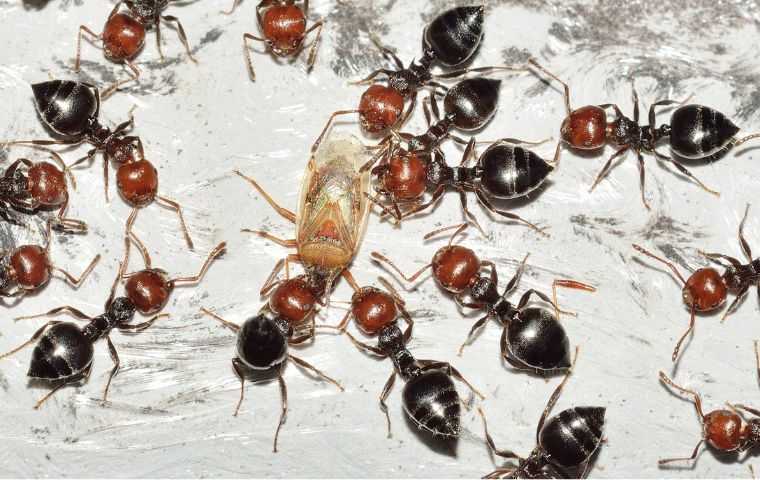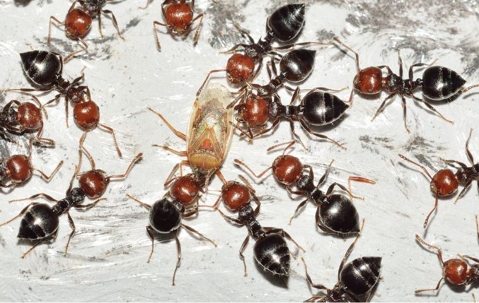How Do We Get Rid Of Ants?
September 04, 2023 - Ants

One of the questions we get asked all the time as pest control professionals is how we get rid of ants. The short answer is, "It depends," but I'll outline our general process for ant control:
Identify The Ants
Identifying ants is a crucial first step before attempting to control them. Ants are social insects that come in various species, and understanding the specific type of ant infesting your home or business is essential for implementing effective control measures. Some types of ants can only be effectively treated with ant bait, while others may not be attracted to (or even feed on) ant baits at all. Some types of ants are easiest to deter with an ant repellent spray, but some types of ants should never be treated with any type of ant spray, since they may split into multiple colonies and go into reproductive overdrive! Here are some features we may use to identify ants before implementing the appropriate treatment method(s):
Size and Color: Ants vary in size and color. Observe the size of the ants; are they small, medium, or large? Note their color; some are black, brown, red, or even a combination of colors. These physical characteristics can provide initial clues.
Antenna and Body Segments: Examine the ants closely to see if they have elbowed antennae and a distinctive body with three segments: head, thorax, and abdomen. This three-part body structure is a hallmark of ants.
Waist and Node: Look at the ant's waist and whether it has one or two nodes. Ants with a single, narrow waist are called "waisted ants," while those with two nodes have a "double-waist." This differentiation is significant in identification.
Thoracic Spines: Some ants have thoracic spines or bumps on their thorax. Take note of these features, as they can be helpful in distinguishing different ant species.
Habits and Nesting: Pay attention to their behavior and nesting habits. Are they foraging for food in a specific way? Do they nest underground, in wood, or indoors? These behaviors can provide valuable insights.
Identifying ants before attempting to control them is a vital step in effective pest management. By paying attention to their size, color, body structure, waist type, thoracic spines, and habits, you can determine the ant species infesting your area. This knowledge is essential for selecting the most appropriate and targeted control methods to rid your environment of these unwelcome intruders.
Ant Killer Powder
Applying insecticide dusts can be an effective method for eliminating ants, especially after identifying the specific ant species infesting your space. Insecticide dusts work by adhering to the ants' bodies and being carried back to the colony, ultimately eradicating the entire population.
Identify Target Areas: We begin by locating the specific areas where ants are most active, such as entry points, ant trails, and nesting sites. Accurate identification of these areas is crucial for successful treatment.
Choose the Right Insecticide Dust: We use an insecticide dust that is labeled for ant control and suitable for indoor or outdoor use, depending on the infestation's location. Follow the product's instructions carefully.
Application Techniques: We apply the insecticide dust directly into the target areas using a duster or a bulb applicator, focusing on cracks, crevices, wall voids, and other places where ants are active. Dust lightly to create a thin, even layer.
Allow Ants to Carry Dust Back: Insecticide dusts are slow-acting. Ants that come into contact with the dust will carry it back to the nest, inadvertently contaminating their colony members.
Reapply as Needed: We monitor the treated areas for ant activity regularly. If you observe continued ant presence, reapply the insecticide dust as directed on the product label. Persistence is key to complete eradication.
Maintain Safety: Keep treated areas off-limits to pets and children until the dust has settled and it is safe to re-enter.
Applying insecticide dusts to get rid of ants is a meticulous process involving identification of target areas, selecting the appropriate dust, taking safety precautions, applying the dust with care, allowing ants to carry it back to the nest, monitoring, and reapplication as needed. This method is a valuable tool in ant control, particularly when dealing with persistent ant infestations of known species.
Non Repellent Insecticide
Using a non-repellent insecticide in conjunction with insecticide dusts can be an effective strategy for eradicating ants, especially after we have already applied dusts to target specific areas. Non-repellent insecticides work by allowing ants to come into contact with the treated surface and then carry the insecticide back to their colony, which helps eliminate the entire ant population. Here's a detailed explanation of how to use a non-repellent insecticide after applying insecticide dusts:
Identify Target Areas: We begin by identifying the specific areas where ants are active. These are typically entry points, ant trails, and nesting sites.
Choose the Right Non-Repellent Insecticide: We select a non-repellent insecticide that is labeled for ant control. We ensure it is compatible with the insecticide dust you previously applied and follow the product's instructions meticulously.
Application Techniques: We apply the non-repellent insecticide to the same areas where we applied the insecticide dust, focusing on cracks, crevices, wall voids, and other areas with ant activity. The non-repellent nature of the insecticide will allow ants to come into contact with it without sensing its presence.
Be Strategic: We ensure that the non-repellent insecticide does not disrupt the existing insecticide dust layer. We want both products to work together effectively.
Allow Ants to Carry the Insecticide: Non-repellent insecticides have a delayed-action effect, allowing ants to carry the product back to their nest. This contamination will lead to the gradual elimination of the entire ant colony.
Monitor and Reapply as Necessary: Regularly check treated areas for ant activity. If you still observe ants after some time, it may be necessary to reapply the non-repellent insecticide. Follow the product label for reapplication guidelines.
If the ant infestation persists or becomes overwhelming, consider consulting a pest control professional who can assess the situation and apply the appropriate insecticides effectively.
Using a non-repellent insecticide after applying insecticide dusts involves careful selection, safety precautions, strategic application, and ongoing monitoring. This integrated approach can enhance the effectiveness of ant control efforts, as both products work synergistically to eliminate the ant colony and prevent future infestations.
Ant Baits
Using ant baits is a highly effective method for eliminating ant colonies. Ant baits work by attracting ants to a toxic substance that they carry back to their nest, inadvertently poisoning the entire colony. Here's how we use ant baits effectively:
Choose the Right Ant Bait: We select ant baits that are specifically designed for the type of ants we have identified. There are various types of baits available, including liquid, gel, and solid forms. We read the product labels carefully to ensure they are suitable for your ant species.
Identify Ant Trails and Entry Points: We locate the ant trails and entry points where ants are most active. Placing baits along these routes increases the likelihood of ants finding and taking the bait back to the nest.
Prepare the Bait Stations: If using bait stations, open them according to the manufacturer's instructions. If you have a gel or liquid bait, use small, clean containers (e.g., bottle caps) to hold the bait and prevent spillage.
Place Baits Strategically: We position bait stations or bait-filled containers near ant trails, entry points, or where you've observed the highest ant activity, without placing them directly on the ants' paths, as this may deter them.
Monitor and Refill: Check the bait stations regularly to ensure they remain filled with bait. Refill them as needed until ant activity significantly decreases or disappears.
Avoid Using Other Pesticides: We refrain from using other pesticides or insecticides in the vicinity of the baited area, as this can interfere with the ants' acceptance of the bait.
Using ant baits involves careful selection of the appropriate bait, strategic placement near ant trails and entry points, patience, monitoring, and maintenance of cleanliness. By following these steps, you can effectively eliminate ant colonies and prevent future infestations, making your living environment ant-free.
Customer Review
Bret is incredible and his service is top notch. During the spring of 2020 we had a skunk infestation and he removed 12 skunks. He also solved our raccoon and squirrel issues. Our pest issues have been nil since hiring Bret!


